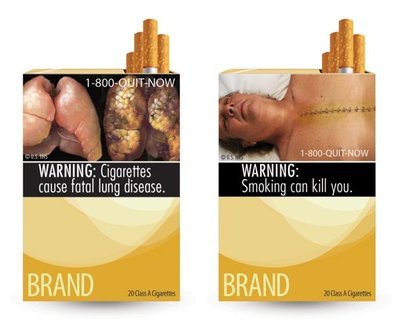U.S. Court Rejects Graphic Cigarette Warnings

A U.S. court on Friday shot down orders to slap graphic anti-tobacco messages on cigarette packs, saying the government overstepped its authority by trying to "browbeat" smokers into quitting.
In line with campaigns in several other nations, the United States planned from September 22 to require images on cigarette packs including a man smoking through a hole in his throat and a body with chest staples on an autopsy table.
In a 2-1 decision, the U.S. Court of Appeals in Washington said that the images planned on cigarette packs were not necessarily false but they went beyond "pure attempts to convey information to consumers."
"They are unabashed attempts to evoke emotion (and perhaps embarrassment) and browbeat consumers into quitting," Judge Janice Rogers Brown, who was appointed by former president George W. Bush, wrote for the majority.
She also said that the U.S. Food and Drug Administration "has not provided a shred of evidence" that graphic warnings directly reduced rates of smoking.
Tobacco companies had filed suit against the federal agency, saying that the cigarette labels violated the U.S. Constitution's First Amendment which prohibits any law that restricts freedom of speech.
Brown wrote that the government "can certainly require that consumers be fully informed about the dangers of hazardous products."
"But this case raises novel questions about the scope of the government's authority to force the manufacturer of a product to go beyond making purely factual and accurate commercial disclosures and undermine its own economic interest," she wrote.
Brown said the court faced the question of how much leeway to grant the government "to convey the state's subjective -- and perhaps even ideological -- view that consumers should reject this otherwise legal, but disfavored, product."
Brown pointed to the Food and Drug Administration's own statement when announcing the warnings that every pack of cigarettes would become "a mini-billboard" for its message.
Announcing the warnings last year, Health and Human Services Secretary Kathleen Sebelius said that a pack-a-day smoker would see the labels more than 7,000 times a year and present "a very different reality" to young people who might consider smoking to be glamorous.
Sebelius said smoking is related to the deaths of some 443,000 Americans each year, making it the most preventable cause of death, and cost the U.S. economy $200 billion a year in medical costs and lost productivity.
The issue could end up in the Supreme Court. The appeals court was upholding a lower court decision, but a separate bench in Cincinnati said in March that the legislation that paved the way for the warnings was constitutional.
Friday's ruling came nine days after global tobacco firms lost a similar case in Australia, where the High Court upheld laws requiring that tobacco products be sold in drab, uniform packaging with graphic health warnings.
Other nations that place pictorial warnings on tobacco products include Brazil, Britain, Canada, India, Iran, Mexico, New Zealand, Pakistan, Singapore, Taiwan and Thailand.
Brown said that other countries "do not necessarily protect individual liberties as stringently as does the United States Constitution."
In a dissent, Judge Judith Rogers said that the regulation ordering the label "does not restrict the information conveyed to consumers, but requires additional information to be conveyed with the aid of graphic images."
Rogers, who was appointed by former president Bill Clinton, said that tobacco companies had engaged in "decades of deception" over health risks and had no legal basis to complain about "emotional reactions" to graphic warnings.
RJ Reynolds, one of five tobacco companies that brought the lawsuit, welcomed the decision, saying that consumers "should be fully informed about the risks of tobacco use in a manner consistent with the U.S. Constitution."
Recent surveys by Gallup found that 20 percent of Americans said they smoked a cigarette in the past week, an all-time low, and that more Americans now consider obesity rather than smoking to be a serious problem for society.



